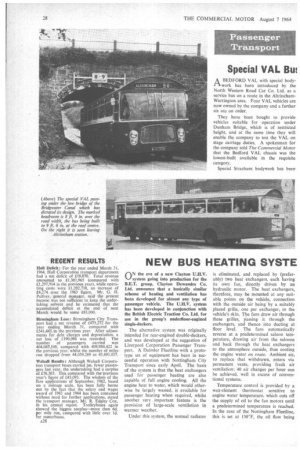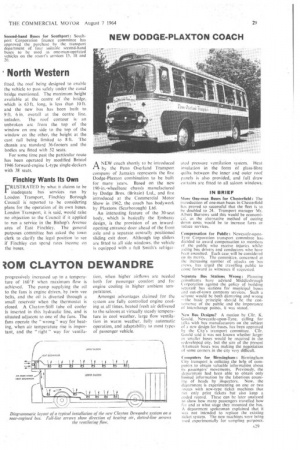NEW BUS HEATING SYSTE 1OM CLAYTON DEWANDRE
Page 30

Page 31

If you've noticed an error in this article please click here to report it so we can fix it.
ON the eve of a new Clayton U.H.V. system going into production for the B.E.T. group, Clayton Dewandre Co. Ltd. announce that a basically similar scheme of heating and ventilation has been developed for almost any type of passenger vehkle. The U.H.V. system has been developed in conjunction with the British Electric Traction Co. Ltd. for use in the group's underfloor-engined single-deckers.
The alternative system was originally intended for rear-engined double-deckers, and was developed at the suggestion of Liverpool Corporation Passenger Transport. A Daimler Fleetiine with a prototype set of equipment has been in successful operation with Nottingham City Transport since early April. The basis of the system is that the heat exchangers used for passenger heating are also capable of full engine cooling. All the engine heat to water, which would otherwise be largely wasted, is available for passenger heating when required, whilst another very important feature is the provision of large-scale ventilation in warmer weather.
Under this system, the normal radiator
is eliminated, and replaced by (preferably) two heat exchangers, each having its own fan, directly driven by an hydraulic motor. The heat exchangers, therefore, may be mounted at any suitable points on the vehicle, connection with the outside air being by a, suitably placed grille, one per exchanger, in the vehicle's skin. The fans draw air through these grilles, passing it through the exchangers, and thence into ducting at floor level. The fans automatically reverse at a predetermined saloon temperature, drawing air from the saloons and back through the heat exchangers to the atmosphere outside, thus cooling the engine water en route. Ambient air, to eplace that withdrawn, enters via permanent vents, providing fresh air ventilation; 40 air changes per hour can be achieved, well in excess of conventional systems.
Temperature control is provided by a wax-element thermostat sensitive to engine water temperature, which cuts off the supply of oil to the fan motors until a predetermined temperature is reached. In the case of the Nottingham Fleetline, this is set at 130'F, the oil flow being progressively increased tin to a temperature of 160°F when maximum flow is achieved. The pump supplying the oil to the fans is engine driven, by twin vee belts, and the oil is diverted through a small reservoir when the thermostat is closed. •A Clayton-Still tube oil cooler is inserted in this hydraulic line, and is situated adjacent to one of the fans. The fans operate the "wrong" way for heating, when air temperature rise is important, and the " right " way for ventila
tion, when higher airflows are needed both for passenger' comfort and for engine cooling in higher arribient temperatures. ,
Amongst advantages claimed for the system are fully controlled engine cooling at all' times, heated-fresh air delivered to the saloons at virtually steady temperature in cool weather, large flow ventilation in warm weather. fully automatic operation, and adaptability to most types of passenger vehicle.
























































































































